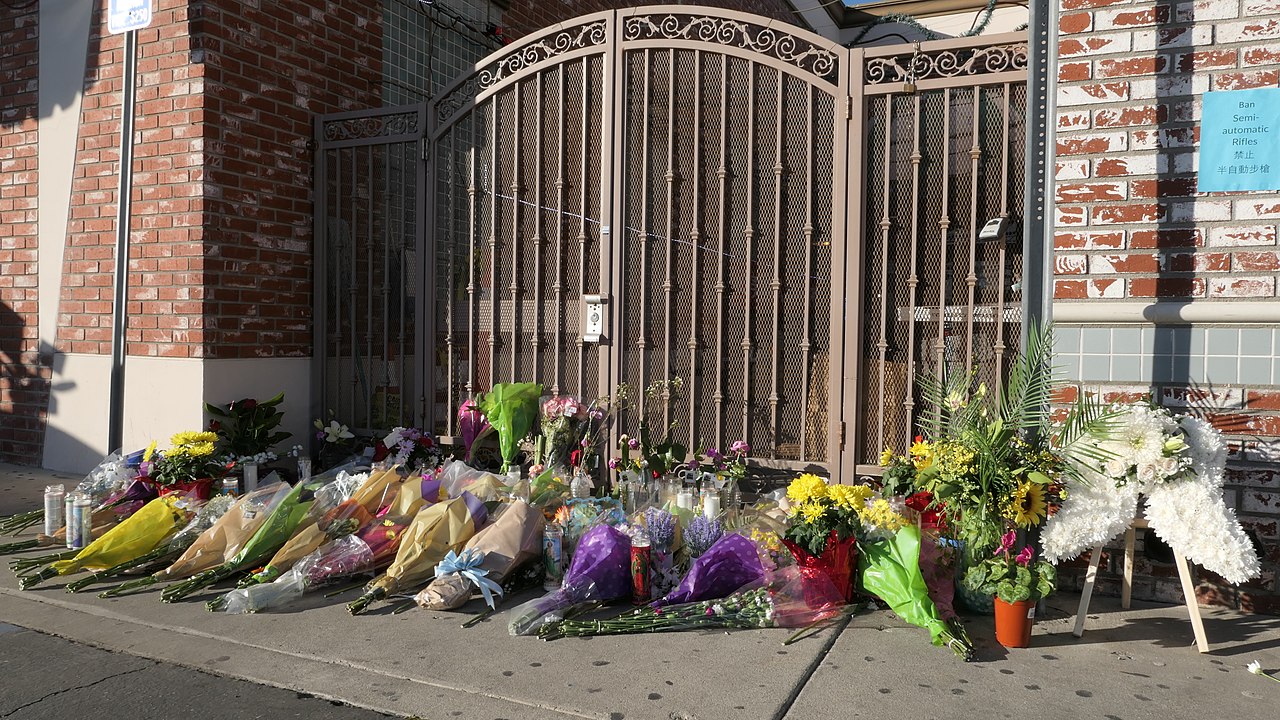(Image: A makeshift memorial outside Star Ballroom Dance Studio in Monterey Park where 11 people were killed in one of two mass shootings in California.)
Both shooters in the two mass killings in Monterey Park and Half Moon Bay, California were Chinese and neither fit the profile of a mass killer. Both were over 65.
“Is it any surprise that within our communities there are people, elders who have been made invisible, treated not even as human beings, who feel isolated and yes, experience mental health issues like any other community?” asked Helen Zia, an author and activist.
Zia was one of five speakers at a Feb. 3 EMS virtual briefing who shared perspectives about the isolation and invisibility of immigrant elders spotlighted by the tragedies, and a call to action for the rest of society.
For her latest book, “Last Boat Out of Shanghai,” Zia interviewed a few hundred Asian seniors about their lives – first as refugees, and later as exiled immigrants. “So many have gone through war, starvation, civil war, great trauma, witnessed terrible, terrible things,” Zia said. Many had never told their stories before, even to their grown children. When asked why, they said because they didn’t think anybody wanted to hear.
The recent killings triggered memories that many immigrants have tried to forget, and the news brought panic and fear. Perfectly understandable, Zia says.
Working into their ‘golden years’
“Why are people still working in their seventies?” asked Rita Medina, Deputy Director of State Policy and Advocacy at the Coalition for Humane Immigrant Rights Los Angeles (CHIRLA), referring to the Latino and Asian farm workers spotlighted in Half Moon Bay.
Medina says many older farmworkers continue to work “into what should be their golden years” because they have to. “It’s a large number of folks we’re talking about.” The 2019 American Community Survey estimated there are about 17,000 undocumented seniors in California who can’t collect social security. Estimates put the number of undocumented farmworkers at around half of the roughly 162,000 who work in the state.
CHIRLA knows domestic workers, farm workers, street vendors, and construction workers who have waited more than a decade to adjust their immigration status. Since many have worked “under the table” or had low-wage social security jobs, Medina says SSI benefits for many wouldn’t be enough to sustain them even if they got green cards.
“They continue to be undocumented. Some of them are alone here in this country, and their bodies are physically breaking down because of the work that they’re doing. Knee problems from bending in construction, back problems from working as a domestic worker,” Medina said.
California recently passed a health care law that will provide medical insurance to everybody in California regardless of their status. That is good news but it doesn’t start until 2025.
Hidden traumas
Laura Som is a Cambodian Chinese refugee who came to Los Angeles when she was 10-years-old along with thousands of other Cambodians escaping the Pol Pot regime.
“Long Beach has the largest Cambodian population in the nation. Many of these refugees experienced extreme violence and trauma during the genocide. Many had and have PTSD, including myself,” Som said.
As she grew up, Som watched the mental health of the elders in her community deteriorate “from the aftermath of wars, extreme violence and neglect by the mainstream community. Some of the symptoms of these traumas are hatred, violence, rage, and depression. Little has been done to shield young children from it,” she said.
Degreed in biochemistry, Som founded the Maye Center in Cambodia Town in Long Beach to provide culturally appropriate therapies for mental health wellness for refugees and immigrants.
Noting her community ended gerrymandering in Long Beach, Som says Cambodian seniors don’t speak English but overcame their fear and organized for the good of everyone. Transforming trauma into activism overcomes fear, especially when community initiatives are successful, Som says.
“And so for us, we break the stigma by saying seniors are relevant.”
The stigma of mental health
Dr. Brett Sevilla is a clinical psychiatrist and medical director of the Asian Pacific Counseling and Treatment Centers (APCTC) which serves predominantly monolingual Asian immigrant families in Southern California.
Sevilla said families who have members with mental illness often consider it shameful and will first try to contain the problem and keep the person at home.
“If they eventually do see a psychiatrist, the person is often severely impaired, angry about being accused of being crazy, and the family is exhausted. Medications may be rejected or not taken consistently, as Western medication is believed to be too strong or even a cause of mental illness.”
Sevilla’s agency overcame these barriers by locating their offices in Asian enclaves, placing staff in local schools, providing culturally affirming services in the client’s native language, and linking families to community resources for practical support.
A decade ago, Linda Yoon, co-founder of the Yellow Chair Collective providing culturally appropriate therapy to Asian Americans in Los Angeles, fell into working with seniors at a Korean housing complex.
“One of the tasks that I was given was doing assessments, wellness checks, for every single resident.” Yoon said.
She said a lot of the residents were older women who lived alone and they would talk to her about their traumas, all the challenges they were going through, and things they just never shared with their children.
“And a lot of them end up kind of crying, really sharing something and then also feeling embarrassed because I was such a young worker that they were sharing something so intimate. There was just so much hidden trauma, isolation and loneliness that I was able to witness,” Yoon said.
She often complains with colleagues that children and families get the lion’s share of resources and they could use more—it’s part of the stigma of being invisible seniors.




